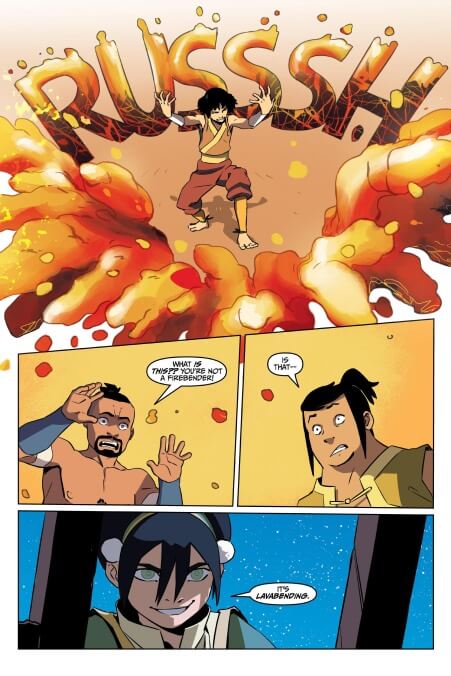Introduced at the end of the series’ second season by fan favorite Toph Beifong, metalbending went on to become a more common ability in the sequel series The Legend Of Korra. (Several characters in the supporting cast, including Toph’s daughters and grandchildren, are metalbenders.) If you’ve seen any metalbending action from Korra, you might be excited for Toph Beifong’s Metalbending Academy, a standalone graphic novel whose premise is right there in the title.
But despite what the title would suggest, there isn’t much of the academy to go around. Perhaps because Toph’s troubles with her school have been the subplots of earlier books, Metalbending is more focused on Toph’s internal drama—namely, that everything is running smoothly, and the routine of school is starting to sink in for her.
Turning your talent into your job can be draining, and Toph is the right character to have those feelings. It’s only when she discovers that a kid named Sun has the ability to lavabend—another earth subtype introduced in Korra’s third season—that Toph sees a way out of her funk. The book is structured like an episode of the series, which helps it feel familiar while also highlighting its shortcomings. Before the arrival of a Katara-focused one-shot released last year (and another meant for Suki coming in June), the other Avatar graphic novels have been trilogies, and Metalbending feels like it should be a two-parter, at the very least. Toph on her own, removed from the rest of Team Avatar (Sokka and Suki are here for a cameo at the start and end), is a situation that deserves more. It’d also help flesh out Sun, who feels more like a plot device than a real person.
Short as it is, there’s still plenty to enjoy about Metalbending. Having written Toph during the Imbalance trilogy, cartoonist Faith Hicks most effectively nails the character in terms of writing, providing a good chemistry with the goofy musician Chong, creator of the catchiest song in the original show. Peter Wartman’s art is simple, but it’s a style that fits; when it comes time for bending action, he comes through, most notably when Sun unleashes his full lavabending power and the sound effects become covered in magma. You’ll likely come away from this wanting more, whether it’s more from the story or just more metal and lavabending action. (Like Korra, the latter here doesn’t get much beyond people slamming their fists into the ground.) That’s not a bad problem to have—especially for a franchise that’s about to expand in the near future.


 Keep scrolling for more great stories from A.V. Club.
Keep scrolling for more great stories from A.V. Club.